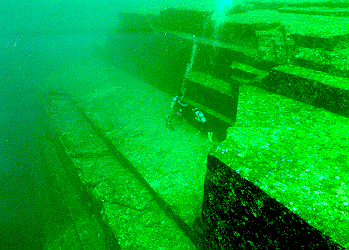 This story was originally revealed
by Laura Lee nearly a year ago. For her update on this amazing discovery,
see link at end of this article.
This story was originally revealed
by Laura Lee nearly a year ago. For her update on this amazing discovery,
see link at end of this article.
 This story was originally revealed
by Laura Lee nearly a year ago. For her update on this amazing discovery,
see link at end of this article.
This story was originally revealed
by Laura Lee nearly a year ago. For her update on this amazing discovery,
see link at end of this article.
A STRUCTURE thought to be the world's oldest building, nearly twice the age of the great pyramids of Egypt, has been discovered. The rectangular stone ziggurat under the sea off the coast of Japan could be the first evidence of a previously unknown Stone Age civilisation, say archeologists.
The monument is 600ft wide and 90ft high and has been dated to at least 8000BC. The oldest pyramid in Egypt, the Step Pyramid at Saqqara, was constructed more than 5,000 years later.
The structure off Yonaguni, a small island southwest of Okinawa, was first discovered 75ft underwater by scuba divers 10 years ago and locals believed it was a natural phenomenon.
Professor Masaki Kimura, a geologist at Ryukyu University in Okinawa, was the first scientist to investigate the site and has concluded that the mysterious five-layer structure was man-made. "The object has not been manufactured by nature. If that had been the case, one would expect debris from erosion to have collected around the site, but there are no rock fragments there," he said.
The discovery of what appears to be a road surrounding the building was further evidence that the structure was made by humans, he added.
Robert Schoch, professor of geology at Boston University, dived at the site last month. "It basically looks like a series of huge steps, each about a metre high. Essentially, it's a cliff face like the side of a stepped pyramid. It's a very interesting structure," he said. "It's possible that natural water erosion combined with the process of cracked rocks splitting created such a structure, but I haven't come across such processes creating a structure as sharp as this."
Further evidence that the structure is the work of humans came with the discovery of smaller underwater stone mounds nearby. Like the main building, these mini-ziggurats are made of stepped slabs and are about 10m wide and 2m high.
Kimura said it was too early to know who built the monument or its purpose. "The structure could be an ancient religious shrine, possibly celebrating an ancient deity resembling the god Nirai-Kanai, whom locals say gave happiness to the people of Okinawa from beyond the sea. This could be evidence of a new culture as there are no records of a people intelligent enough to have built such a monument 10,000 years ago," he said.
"This could only have been done by a people with a high degree of technology, probably coming from the Asian continent, where the oldest civilisations originate. There would have to have been some sort of machinery involved to have created such a huge structure."
Teruaki Ishii, professor of geology at Tokyo University, said the structure dated back to at least 8000BC when the land on which it was constructed was submerged at the end of the last ice age. "I hope this site is artificial as it would be very exciting. But at this time I feel it is too early to say. I think the structure could be natural, but part of it may have been made," he said.
The first signs of civilisation in Japan are traced to the Neolithic period around 9000BC. The people at this time lived as hunters and food-gatherers. There is nothing in the archeological record to suggest the presence of a culture advanced enough to have built a structure like the ziggurat.
British archeologists are, however, cautiously enthusiastic about the discovery which will be featured this summer in a Channel 4 documentary.
Jim Mower, an archeologist at University College London, said: "If it is confirmed that the site is as old as 10,000 years and is man-made, then this is going to change an awful lot of the previous thinking on southeast Asian history. It would put the people who made the monument on a par with the ancient civilisation of Mesopotamia and the Indus Valley."